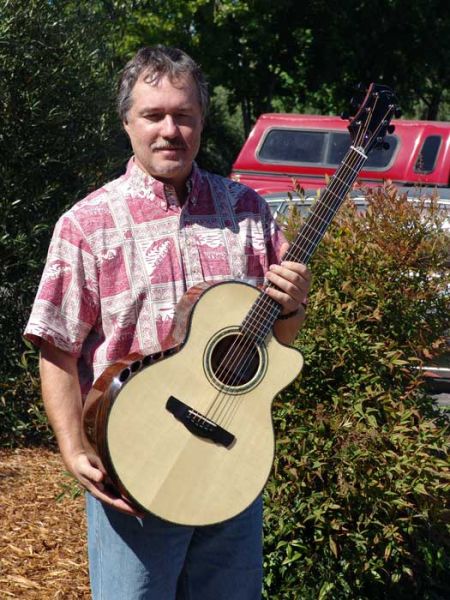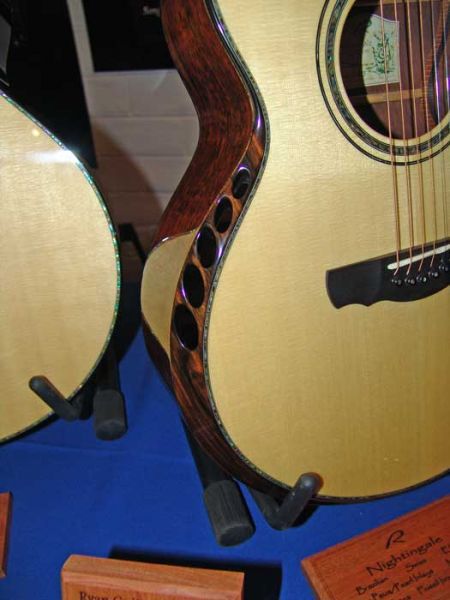John
Ryan Bevel
- woodrat
- Blackwood
- Posts: 1155
- Joined: Tue Nov 25, 2008 6:31 am
- Location: Hastings River, NSW.
- Contact:
Ryan Bevel
I'd like to hear if anybody who has built a guitar with a "Ryan" bevel. It looks quite challenging , especially getting the perfeling to work. One always has to have something to aim for! 
John
John
This what you're looking for?
0M with armrest
It's a hell of a lot of extra work, as you'd expect, and pretty daunting to contemplate on starting, but I was surprised at how easy it actually turned out to be. Perhaps first time lucky though.
0M with armrest
It's a hell of a lot of extra work, as you'd expect, and pretty daunting to contemplate on starting, but I was surprised at how easy it actually turned out to be. Perhaps first time lucky though.
-
Pete Brown
- Blackwood
- Posts: 115
- Joined: Tue Dec 09, 2008 1:15 pm
An armrest is on my list of things to do and seems slightly less daunting after discovering this excellent set of instructions on Matt Mustapick's web site:
The main challenge is to end up with a solid beveled surface for the veneer, and yet to have good right-angle purfling ledges. Here are some pictures to go along with the description below…
http://mustapickguitars.com/47paskins/3/index.html
http://mustapickguitars.com/47paskins/4/index.html
http://mustapickguitars.com/47paskins/5/index.html
http://mustapickguitars.com/47paskins/6/index.html
1) With the rim assembled and in my outside mold I took a bit of mahogany neck blank and traced the outline of the inner surface of the side in the area that was to become the bevel onto the neck blank. Then I sanded cut and sanded the neck blank into the shape of the side so that it matched the shape of the side.
2) On a belt sander, sand away the side to a nice smooth graceful line that looks right to you.
3) The edge where you sanded will be about 10 degrees off square relative to the side. This edge is going to serve as your purfling ledge...so use a sanding block to square it.
4) Put the profiled piece of mahogany back where it was, and, with a pencil, trace the profile of the sanded out side onto the mahogany lining.
5) Doing your best to maintain a steady angle for the bevel, use a belt sander (I have an edge sander) to sand to the line. If your traced pencil line of the side profile is smooth and your hand is steady with respect to the angle of the bevel your sanding in...you'll naturally get a nice smooth curve for the top as well. Just keep an eye on that as you're going along.
6) Now you have a smooth curve on the top-side of your mahogany reinforcement that will establish the shape of the top. With a pencil, draw a line offset from this 1/4" in. This is the ledge where your top purfling and top will glue onto. Cut and sand to that line. Make the cut perpendicular to the top (parallel to the side) so that it's easier to clamp to the side.
7) Sand the side-height of your reinforcement to whatever makes sense to you, (perhaps no less than 3/16" below the lowest point of the bevel).
 Glue-clamp the side reinforcement onto the side. Glue the kerfing/lining on elsewhere as you normally do.
Glue-clamp the side reinforcement onto the side. Glue the kerfing/lining on elsewhere as you normally do.
9) Hog off all that unnecessary wood from the part of the reinforcement that's inside the guitar that was left square for clamping purposes.
10) Trace the profile of the kerfing-lining and bevel reinforcement onto the underside of your top...very precisely.
11) Brace the top and prepare it for assembly to the rim. I did not tuck the x-brace into the bevel reinforcement...I let it thin down to nothing at that juncture.
At this point, the *exact* location of the top needs to be nailed down without margin for error so the next two steps ensure that it will glue down without the least uncertainty...
12) With the top in its exact place, drill a hole down through the top and into the headblock. Use a toothpick that can stick into the headblock and up through the top to lock in this location.
13) Use some light adhesive to tack down something to the underside of the top so that the bevel reinforcement can rest against it as a precise stop for purposes of locating the top while the glue is setting.
14) Before gluing the top into the rim, very slowly and carefully sand away the area of the top at the bevel so that it's line matches the presented by the line presented by the top of the reinforcement. Continue sanding to this contour until enough room is left that presents a ledge for your top-side purfling to rest on.
15) Glue your top on oh-so-precisely so that the purfling ledge you've left for the top is lined up just right.
16) After you've glued on the back, rout your binding and purfling channels in the usual way so that the channels disappear into the void left by the bevel platform.
17) Trim-sand your binding at the proper sharp angle so that it will intersect properly bevel veneer. It's hard to talk about clearly, but not so hard to visualize when you're standing there playing with the ledges and purfling and the binding and making things fit.
18) Glue the binding-purfling on in the usual way. You'll be starting at the tailblock with just a short piece of binding that quickly dies away. In the area of the bevel you'll need to continue gluing on the purfling but without the binding there to act as a clamping call. I found that I could easily just "massage" it into place as the wood glue tacked up. Once you’re past the bevel, you just continue with the other side with the binding that you've prepared.
19) Thin your veneer for the bevel. I found that with koa I could thin it to .060". This was thin enough so that it flexible enough to just flop in without any prebending, but thick enough to fill the space left for bevel.
20) This is slightly tedious...you've got to shape that bevel veneer so that it just fits inside the area left between the binding, with the backside of it beveled to rest against the the side and top purfles. In order to arrive at the approximate shape for my veneer I put a piece of butcher paper over the area and used a pencil to creating a rubbing shape of the bevel. Then a cut out a piece of construction paper a bit oversize to this shape. Having shaped the construction paper, just a wee bit oversized, I then cut out a piece of practice veneer and got it just so....lots of patience, a belt sander, a spindle sander, one inch at a time. Then I traced this outline on my final piece of veneer, but it a bit oversized and repeated. I won't need to do the practice step next time, I just didn't want to learn on a pretty piece of koa.
21) Glue in the veneer with wood glue, holding it down with masking tape the way you ordinarily would for binding.
22) Wait an hour...remove the tape...sand things flush.
23) Pat yourself on the back, show your girlfriend.
The main challenge is to end up with a solid beveled surface for the veneer, and yet to have good right-angle purfling ledges. Here are some pictures to go along with the description below…
http://mustapickguitars.com/47paskins/3/index.html
http://mustapickguitars.com/47paskins/4/index.html
http://mustapickguitars.com/47paskins/5/index.html
http://mustapickguitars.com/47paskins/6/index.html
1) With the rim assembled and in my outside mold I took a bit of mahogany neck blank and traced the outline of the inner surface of the side in the area that was to become the bevel onto the neck blank. Then I sanded cut and sanded the neck blank into the shape of the side so that it matched the shape of the side.
2) On a belt sander, sand away the side to a nice smooth graceful line that looks right to you.
3) The edge where you sanded will be about 10 degrees off square relative to the side. This edge is going to serve as your purfling ledge...so use a sanding block to square it.
4) Put the profiled piece of mahogany back where it was, and, with a pencil, trace the profile of the sanded out side onto the mahogany lining.
5) Doing your best to maintain a steady angle for the bevel, use a belt sander (I have an edge sander) to sand to the line. If your traced pencil line of the side profile is smooth and your hand is steady with respect to the angle of the bevel your sanding in...you'll naturally get a nice smooth curve for the top as well. Just keep an eye on that as you're going along.
6) Now you have a smooth curve on the top-side of your mahogany reinforcement that will establish the shape of the top. With a pencil, draw a line offset from this 1/4" in. This is the ledge where your top purfling and top will glue onto. Cut and sand to that line. Make the cut perpendicular to the top (parallel to the side) so that it's easier to clamp to the side.
7) Sand the side-height of your reinforcement to whatever makes sense to you, (perhaps no less than 3/16" below the lowest point of the bevel).
9) Hog off all that unnecessary wood from the part of the reinforcement that's inside the guitar that was left square for clamping purposes.
10) Trace the profile of the kerfing-lining and bevel reinforcement onto the underside of your top...very precisely.
11) Brace the top and prepare it for assembly to the rim. I did not tuck the x-brace into the bevel reinforcement...I let it thin down to nothing at that juncture.
At this point, the *exact* location of the top needs to be nailed down without margin for error so the next two steps ensure that it will glue down without the least uncertainty...
12) With the top in its exact place, drill a hole down through the top and into the headblock. Use a toothpick that can stick into the headblock and up through the top to lock in this location.
13) Use some light adhesive to tack down something to the underside of the top so that the bevel reinforcement can rest against it as a precise stop for purposes of locating the top while the glue is setting.
14) Before gluing the top into the rim, very slowly and carefully sand away the area of the top at the bevel so that it's line matches the presented by the line presented by the top of the reinforcement. Continue sanding to this contour until enough room is left that presents a ledge for your top-side purfling to rest on.
15) Glue your top on oh-so-precisely so that the purfling ledge you've left for the top is lined up just right.
16) After you've glued on the back, rout your binding and purfling channels in the usual way so that the channels disappear into the void left by the bevel platform.
17) Trim-sand your binding at the proper sharp angle so that it will intersect properly bevel veneer. It's hard to talk about clearly, but not so hard to visualize when you're standing there playing with the ledges and purfling and the binding and making things fit.
18) Glue the binding-purfling on in the usual way. You'll be starting at the tailblock with just a short piece of binding that quickly dies away. In the area of the bevel you'll need to continue gluing on the purfling but without the binding there to act as a clamping call. I found that I could easily just "massage" it into place as the wood glue tacked up. Once you’re past the bevel, you just continue with the other side with the binding that you've prepared.
19) Thin your veneer for the bevel. I found that with koa I could thin it to .060". This was thin enough so that it flexible enough to just flop in without any prebending, but thick enough to fill the space left for bevel.
20) This is slightly tedious...you've got to shape that bevel veneer so that it just fits inside the area left between the binding, with the backside of it beveled to rest against the the side and top purfles. In order to arrive at the approximate shape for my veneer I put a piece of butcher paper over the area and used a pencil to creating a rubbing shape of the bevel. Then a cut out a piece of construction paper a bit oversize to this shape. Having shaped the construction paper, just a wee bit oversized, I then cut out a piece of practice veneer and got it just so....lots of patience, a belt sander, a spindle sander, one inch at a time. Then I traced this outline on my final piece of veneer, but it a bit oversized and repeated. I won't need to do the practice step next time, I just didn't want to learn on a pretty piece of koa.
21) Glue in the veneer with wood glue, holding it down with masking tape the way you ordinarily would for binding.
22) Wait an hour...remove the tape...sand things flush.
23) Pat yourself on the back, show your girlfriend.
- woodrat
- Blackwood
- Posts: 1155
- Joined: Tue Nov 25, 2008 6:31 am
- Location: Hastings River, NSW.
- Contact:
Ryan Bevel
Thanks for the information and excellent links so far. I am sure that there are many was to divest this feline of its fur! It still scares me a bit!...but then so did guitars in general....  until I amazed myself and made one! Now I cant stop!
until I amazed myself and made one! Now I cant stop!
After looking at at least 1/2 dozen different ways of doing this, I settled on Matt's method as well. I deviated in a few area's, or perhaps I didn't understand his instructions well enough, and just nutted it out for my self.
One thing that I'd highly recommend, is to use dark bindings, as it's much easier to hide the joint's rather than in something like maple for instance. At least until you have a few of these under your belt and are pretty confident.
I've got some construction shots, though not as many as I should have taken, if anyone is interested.
One thing that I'd highly recommend, is to use dark bindings, as it's much easier to hide the joint's rather than in something like maple for instance. At least until you have a few of these under your belt and are pretty confident.
I've got some construction shots, though not as many as I should have taken, if anyone is interested.
- woodrat
- Blackwood
- Posts: 1155
- Joined: Tue Nov 25, 2008 6:31 am
- Location: Hastings River, NSW.
- Contact:
Ryan Bevel
Hi Allen, I would love it if we could see your construction Pics...I am finding it hard to get my head around the concept, mainly how to purfel the bevel area. Maybe I am thicker than some!
Thanks
John
Thanks
John
Here's about the only pictures that I have that might help out.
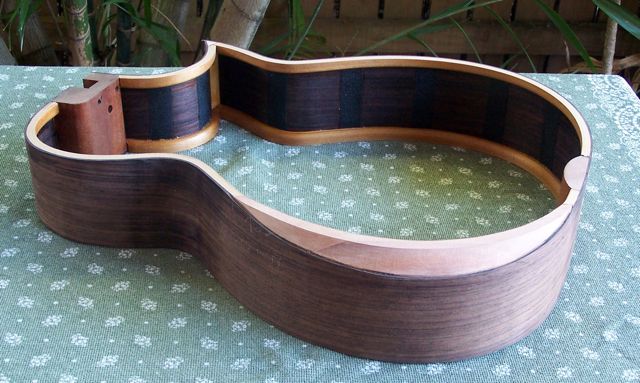
The bevel area that is scooped out of the side was done just as in Matt's tutorial, then the lining area for the bevel is installed. This shows it after it's been shaped and the hours and hours of work to get it to this point are just a faded memory. You will have a step from the sides to the bevel lining the thickness of your sides.
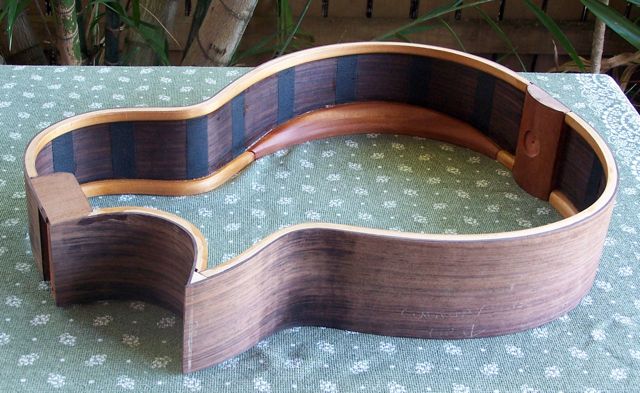
And how it looks inside. This was made up of laminated bits of mahogany. That way I could minimize the amount of short grain when wrapping around the lower bout.
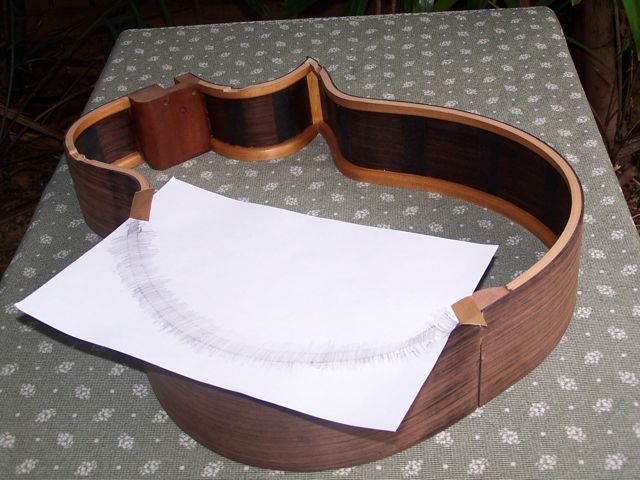
I took a rubbing of the shape of the bevel, and carefully cut it out. When the top was aligned to the body, I penciled in the edge of the inside of the linings, marking where the bevel started and stopped, Then laid out the bevel template on this line to give me an idea where I wanted to trim the top so I ended up with just the right amount inset for my purflings.
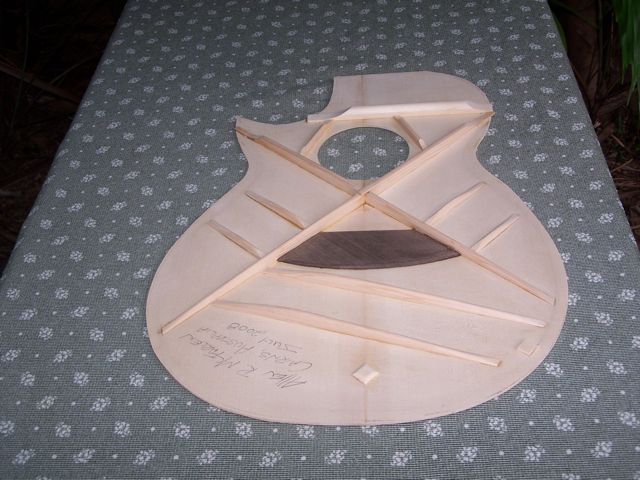
This shot shows the little "Stop Block" on the right hand side. I tacked it there with a dab of hide glue after locating the top in the correct location. That block, along with a small bamboo skewer used as a locating pin through the top and into the neck block (hidden by the fret board) are what holds everything in alignment during glue up. Remove stop block after top is attached.
As for getting purflings and bindings installed, it's a long process. For myself, I felt that there were far to many things to go wrong to try and tackle all of this in one go, so I did it a little at a time. The back can be done as usual, as well as the opposite side of the bevel on the top. However on the bevel side, I installed the purflings around the edge, next to the top by themselves. No bindings. I also installed the purflings on the body side of the bevel, letting them run just a little long.
Now the really tricky part comes, as if you didn't think that up to now was difficult. I took another rubbing of the bevel area using some 2" wide masking tape. I cut the profile out, and taped this to my veneer. This I had previously bent on the iron to an approximate curve to match the bevel. Being a compound curve, it was rather tricky, and lots of back and forth trying to get it close.
Now cut out close to the template, and then I used files, sanding drum etc to keep refining the shape until it fit perfectly. Remember that the edge that you are shaping isn't going to be at 90 degrees, it's going to be a compound angle that is going to try your patience beyond anything that you've attempted before.
Once right, glue it in. I used lots of brown binding tape and epoxy, as I couldn't be 100% sure that I had good wood to wood contact through the entire bevel. Once dry then I used files and chisels to clean up the ends where the bindings would run smoothly into the bevel. And then finally installed the remaining purflings on the body side (ones next to top were installed as one piece previous to bevel veneer) and the bindings. The bindings run just a little long over the bevel. Once dry, sand or file bindings that over hang the bevel into a smooth, seamless transition.
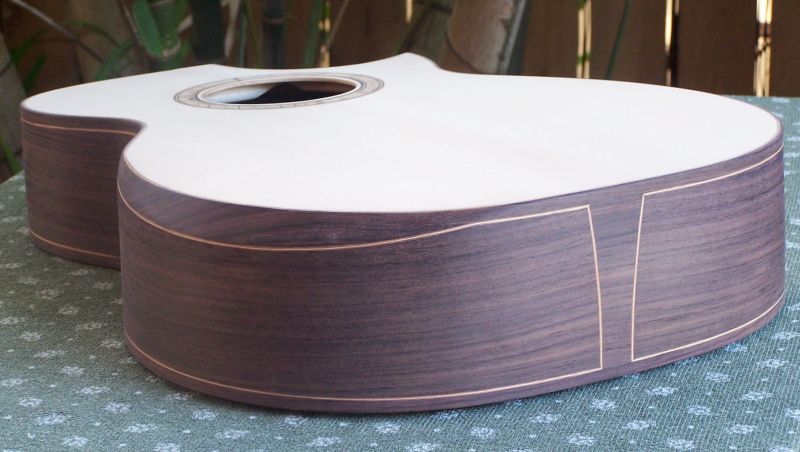
And this is what I ended up with.
Good luck with it. Nothing like diving in and having to make it work.

The bevel area that is scooped out of the side was done just as in Matt's tutorial, then the lining area for the bevel is installed. This shows it after it's been shaped and the hours and hours of work to get it to this point are just a faded memory. You will have a step from the sides to the bevel lining the thickness of your sides.

And how it looks inside. This was made up of laminated bits of mahogany. That way I could minimize the amount of short grain when wrapping around the lower bout.

I took a rubbing of the shape of the bevel, and carefully cut it out. When the top was aligned to the body, I penciled in the edge of the inside of the linings, marking where the bevel started and stopped, Then laid out the bevel template on this line to give me an idea where I wanted to trim the top so I ended up with just the right amount inset for my purflings.

This shot shows the little "Stop Block" on the right hand side. I tacked it there with a dab of hide glue after locating the top in the correct location. That block, along with a small bamboo skewer used as a locating pin through the top and into the neck block (hidden by the fret board) are what holds everything in alignment during glue up. Remove stop block after top is attached.
As for getting purflings and bindings installed, it's a long process. For myself, I felt that there were far to many things to go wrong to try and tackle all of this in one go, so I did it a little at a time. The back can be done as usual, as well as the opposite side of the bevel on the top. However on the bevel side, I installed the purflings around the edge, next to the top by themselves. No bindings. I also installed the purflings on the body side of the bevel, letting them run just a little long.
Now the really tricky part comes, as if you didn't think that up to now was difficult. I took another rubbing of the bevel area using some 2" wide masking tape. I cut the profile out, and taped this to my veneer. This I had previously bent on the iron to an approximate curve to match the bevel. Being a compound curve, it was rather tricky, and lots of back and forth trying to get it close.
Now cut out close to the template, and then I used files, sanding drum etc to keep refining the shape until it fit perfectly. Remember that the edge that you are shaping isn't going to be at 90 degrees, it's going to be a compound angle that is going to try your patience beyond anything that you've attempted before.
Once right, glue it in. I used lots of brown binding tape and epoxy, as I couldn't be 100% sure that I had good wood to wood contact through the entire bevel. Once dry then I used files and chisels to clean up the ends where the bindings would run smoothly into the bevel. And then finally installed the remaining purflings on the body side (ones next to top were installed as one piece previous to bevel veneer) and the bindings. The bindings run just a little long over the bevel. Once dry, sand or file bindings that over hang the bevel into a smooth, seamless transition.

And this is what I ended up with.
Good luck with it. Nothing like diving in and having to make it work.
Who is online
Users browsing this forum: No registered users and 310 guests
